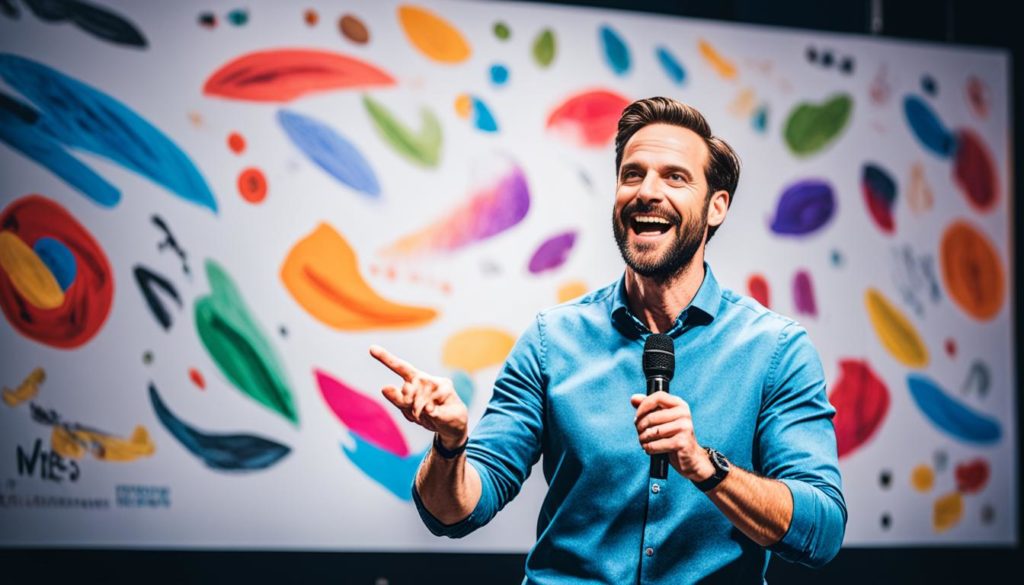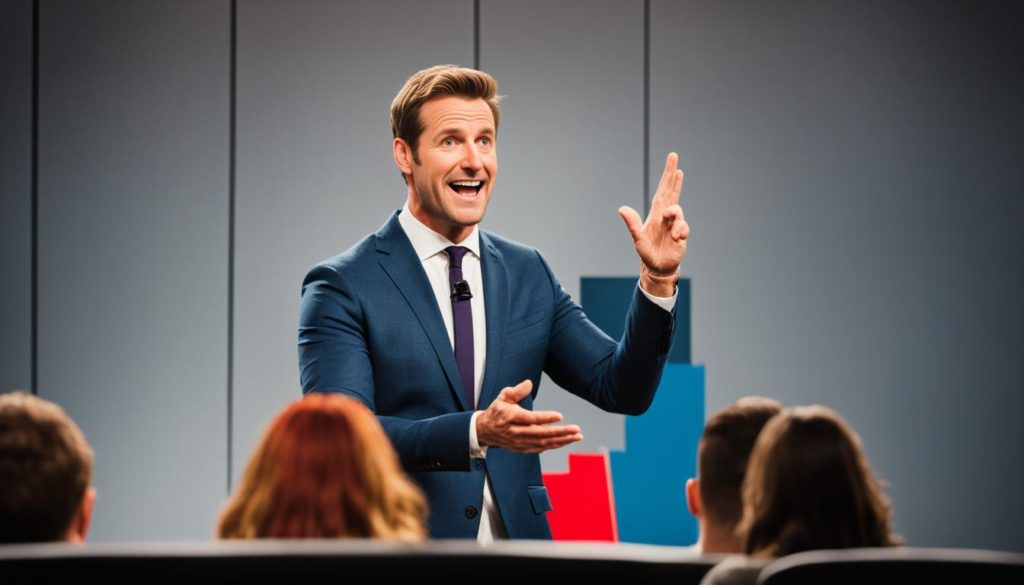
Did you know storytelling makes presentations 22 times more memorable? It shows the strong effect stories have in talks. People remember stories far better than just facts. Al Gore’s “An Inconvenient Truth” is a perfect example. It used stories to explain complex science about climate change. After it came out, more people started acting on climate issues.
Al Gore’s mix of stories and facts wasn’t just effective; it was inspiring. Storytelling in talks lets us connect and get people on board with our ideas. It works in all fields.
Key Takeaways
- Storytelling in presentations enhances audience memory retention.
- Engaging presentations combine emotional narratives with factual data.
- Historical examples, like “An Inconvenient Truth,” highlight storytelling’s impact.
- Narrative techniques can transform complex information into relatable content.
- Effective presentation storytelling can motivate audience action and support.
The Power of Storytelling in Presentations
Why is storytelling so effective in presentations? It connects with our brains in a special way. Uri Hasson, a neuroscientist, found that stories sync listeners’ brains. This means stories can emotionally and intellectually engage us, making them powerful for presenters.
Why Stories Captivate Audiences
Good stories have a hero, challenge, journey, and resolution, like in “Harry Potter.” These elements trigger emotional responses and build trust. A survey mentioned in the power of storytelling in presentations found that 74% believe stories help understand business insights. Stories encourage audiences to embrace new ideas.
Cisco Systems changed from data-heavy to story-centric presentations. Their stories made messages more powerful and improved success. Effective storytelling makes data memorable and engaging. It improves information retention.
Historical Relevance and Modern Applications
Storytelling has ancient roots and has been used for centuries. Techniques like ‘Monomyth’ and ‘Nested Loops’ engage audiences effectively. They help present complex ideas in an engaging way. Nancy Duarte suggests using a three-act structure to build tension and emotional impact.
The Budweiser lost dog commercial and Amy Purdy’s TED Talk show the power of the hero’s journey. John Ortberg and Al Gore used stories to inspire and effect change. For example, Gore’s movie led to a 50% increase in carbon offset purchases.
Martin Luther King Jr. and Viola Davis used contrast to motivate. They showed the difference between reality and what could be. Personal stories, like Steve Jobs’, build empathy and drive action. Jobs’ storytelling made Apple users loyal.
Making presentations into stories makes complex data understandable and memorable. Successful stories and case studies are strong social proof, boosting your presentation’s impact.
Storytelling Techniques to Engage Your Audience
Using stories in your talk is a powerful way to capture everyone’s interest. A well-told story can turn a simple presentation into an inspiring moment. Let’s look at some ways to make your story stick with your audience.
Using the Hero’s Journey
The hero’s journey is a classic story format used in many stories and movies around the world. It works well in presentations, especially when you make your audience the hero. For example, Budweiser ads and Amy Purdy’s TED Talk are great at this. They encourage people to face challenges and find solutions.
When you make your audience the hero, they feel empowered to face their own challenges. This way, your message is not only attention-grabbing but also memorable. Learn more about these storytelling strategies for presentations to improve how you tell stories.
Building Suspense with Contrast
Creating suspense is key to keeping people interested. Using sparklines to show the difference between now and a better future can pull people in. This approach has been used in famous speeches to inspire change.
Starting your story in the middle of action using the in medias res technique grabs attention right away. Using a false start to surprise your audience can also make them tune in closer. You can learn how to keep your audience on the edge of their seats.
Storytelling methods like the mountain structure or nested loops make your story more interesting. They add depth and tension, explaining your main point in a more engaging way.
| Technique | Purpose | Example |
|---|---|---|
| Hero’s Journey | Engage the audience with a protagonist’s journey towards a goal | Budweiser commercials, Amy Purdy’s TED Talk |
| Sparklines | Motivate audiences by contrasting the current state with an improved world | Famous speeches |
| In Medias Res | Grab and maintain audience attention by starting in the midst of action | Engaging literature and films |
| False Start | Capture attention by disrupting a predictable narrative | Innovative presentations |
| Mountain Structure | Build tension through a sequence of challenges leading to a climax | Inspirational speeches and talks |
| Nested Loops | Layering multiple narratives to explain a central concept | Complex storytelling and presentations |
Incorporating Storytelling into Corporate Presentations
Turning a regular presentation into something captivating is key. Did you know 91% of employees daydream during meetings? Adding storytelling techniques helps catch and keep their attention.
Personal Anecdotes to Build Empathy
Telling personal stories can really pull people in. Like Pastor John Ortberg, using personal examples can make your message hit home. It makes things relatable and sticks with your audience. Just look at Airbnb. They use stories of belonging and adventure. We can do the same by sharing experiences that tie back to our topic. It builds trust and connects us with our audience on a deeper level.
Data Narratives for Complex Information
Dealing with complicated info in presentations can be tough. But, turning data into a story can make it interesting and easy to get. Storytelling can also spark a stronger connection and trust, as findings from the Journal of Neuroscience highlight. We should tell stories that make our data clear and memorable. By using the SCQA method, we make sure our message is clear and our audience stays with us.
Storytelling in corporate presentations makes a big difference. Stanford’s research says we remember stories better than simple facts. These techniques help our audience understand better and make informed decisions. They make our communications more powerful.
Real-World Examples of Effective Presentation Storytelling
Real-world storytelling has a big impact on how good presentations are. It is shown through many examples.
One strong case is Al Gore’s An Inconvenient Truth. He tells stories to highlight the urgency of climate change and encourages action. He mixes personal stories, data, and visuals. This method makes his message clear and memorable, showing storytelling success.
Professional speakers also use stories to grab their audience’s attention. They often start in the middle of a story with the In medias res method. This shocks and engages the audience from the start. Another way is Converging ideas, which combines stories for a unified message. These techniques help keep the audience interested and get complex points across.
We’ve listed important parts of storytelling in presentations below:
| Element | Description | Example |
|---|---|---|
| Personal Anecdotes | Using personal stories to connect and build empathy. | Al Gore’s climate stories |
| Data Narratives | Telling a story with data to make complex info understandable. | Data use in An Inconvenient Truth |
| In Medias Res | Beginning the story in the middle to instantly catch attention. | Used by pros |
| Converging Ideas | Merging different stories into one clear message. | Techniques in speech |
Conclusion
As we look back on the journey of storytelling in presentations, we see its huge impact. Stories have the power to catch and hold an audience’s attention. They have been important since ancient times and still are in the modern world.
Using stories in speeches, or in business, works beyond just the setting. By adding storytelling techniques like the Hero’s Journey or using suspense, we make our talks unforgettable. Personal stories and data combined can make complex ideas clear and engaging. Examples from different fields show that stories stick with people.
By focusing on storytelling, we make our presentations soar. Stories do more than share info—they make it stick. This final thought on storytelling reminds us of its power. It connects us to our audience and inspires action. And most importantly, it leaves a mark that lasts forever.
FAQ
Why is storytelling important in presentations?
Storytelling is key in presentations. It grabs the audience’s attention, making info relatable and memorable. Stories stir feelings like trust and empathy. This opens the audience up to new ideas.
How did Al Gore use storytelling in “An Inconvenient Truth”?
Al Gore combined emotional stories with science in “An Inconvenient Truth.” His method showed the urgency of fighting climate change. This boosted public awareness and action.
What are some effective storytelling techniques for presentations?
Good storytelling involves the Hero’s Journey, building suspense, and using structures like the Monomyth and Nested loops. These keep the narrative exciting and the audience hooked.
How can personal anecdotes enhance corporate presentations?
Personal stories create empathy and connect the audience and speaker. They make complex ideas clear and powerful. This is great for corporate talks.
Can data be presented effectively through storytelling?
Yes, storytelling can turn complicated data into engaging stories. It makes the data easy to grasp and remember. This method boosts understanding and persuasion.
What are some real-world examples of effective storytelling in the presentations?
Examples of great storytelling include Al Gore’s “An Inconvenient Truth,” Amy Purdy’s TED Talk, and Budweiser’s ads. They show storytelling’s power to engage people in different settings.
Why should entrepreneurs and corporate leaders adopt storytelling in their presentations?
Entrepreneurs and leaders should use storytelling to captivate and connect with their audience. It transforms dull presentations into compelling stories. These stories can persuade, educate, and inspire action.
Future App Studios is an award-winning software development & outsourcing company. Our team of experts is ready to craft the solution your company needs.









